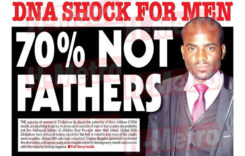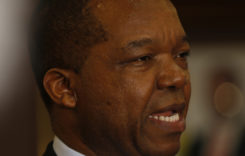Zimbabwe media women have launched a spirited campaign against sex pests in the industry, riding on research and surveys showing the problem of sexual harassment has gone on for years with hardly any sustained programme to tackle the menace.
Globally sexual harassment remains the most frequently cited violation against women in the media. In a 2021 survey by the World Association of News Publishers (WAN-IFRA) Women in News Programme, 41 percent of women experienced verbal sexual harassment, compared to 11 percent of men while 27 percent of women, compared to zero (0) percent of men, experienced physical sexual harassment.
What is sexual harassment?
The International Labour Organisation (ILO) outlines acts of sexual harassment as sex-based behaviour that is unwelcome or offensive to the recipient.
Alongside the ILO, in Zimbabwe, the Labour Relations Amendment Act 2002, No.17 (Amendment of Section 8 of Cap: 28:01 (g) broadly defines sexual harassment as when an employer demands sexual favours from an individual as a condition of employment, creation or abolition of jobs, compensation decisions, training, transfer, promotion, or retrenchment.
These acts of sexual abuse are considered harassment when submission to such conduct is made either explicitly or implicitly as a condition of employment or submission to or rejection of such conduct is used as the basis of employment decisions affecting the individual. A single incident is enough to be considered sexual harassment. Sexual harassment is defined by the nature and the impact of the behaviour, not the intention behind it.
Types of sexual harassment;
Sexual harassment can involve one or more incidents and actions constituting harassment
may be physical, verbal, and non-verbal. Examples of conduct or behaviour that constitute
sexual harassment include, but are not limited to:
- Physical examples of sexual harassment include unwelcome patting, pinching, stroking, kissing, hugging, fondling, inappropriate touching, physical violence including sexual assault, indecent assault, and rape, and the use of job-related threats or rewards to solicit sexual favours.
- Verbal forms of sexual harassment include comments on a worker’s physical appearance, sex life, sexual comments, stories and jokes, unwelcome sexual advances, repeated and unwanted social invitations for dates or physical intimacy, insults based on the sex/gender of the worker, condescending or paternalistic remarks, using inappropriate language.
- Non-verbal signals examples include sexually-suggestive gestures, whistling, eyeing, indecent exposure, and sending sexually explicit messages using electronic gadgets.
What percentage of women in the media have been harassed verbally?
According to a Zimbabwe survey sponsored by the Friedrich Naumann Foundation Africa (FNF) in 2023, 73.42 percent of women in the media have been verbally harassed. In another survey done by Women in News in 2021, 41 percent of women have experienced this harassment in Zimbabwe. Action taken by media organizations is limited, the most common response is a warning to the accused.
What percentage of women in the media have experienced physical sexual harassment?
Research has shown that an estimated 29 percent of women in the news been sexually abused physically. In instances where cases of physical harassment were noted, it is unfortunate that no action was taken against perpetrators who in most hold positions of influence in the surveyed media houses.
How many women in the media have reported cases of sexual harassment?
Overall, only 15.15 percent of women who were victims of sexual harassment in the newsroom were able to report their ordeal to the authorities. In some instances, women holding senior positions provided assistance to victims of sexual harassment.
Why are women reluctant to report sexual harassment?
The majority of women in the newsroom (64.86 percent) do not feel safe in their workspace which forces them to disengage and recline in their shells.
The most common reasons for not reporting are:
- Weak company policies that do not protect women from sexual harassment
- Absence of reporting mechanisms
- Not knowing how to report
- Fear of further victimisation
Does the law fully protect women from sexual harassment?
Zimbabwe is a Member State of the International Labour Organization (ILO) thus the country is automatically bound by the core (ILO) Conventions even in the absence of ratification.
Zimbabwe’s National Constitution spells out the provision of “gender equality” in all forms of work both formal and informal, public or private. However, this section is not supported by tangible statutes that can be adopted and enforced in the workplace to deter offenders.
The Labour Relations Amendment Act (2002) amended in 2021 presents sexual harassment as a criminal offense and prohibits any forms of violence and harassment at the workplace which includes any action in the course of and linked with or arising out of work, communication, work-related trips, as well as in the process of commuting to and from work.
In 2022, the Public Service Commission (PSC) launched the Public Service Sexual Harassment Policy which seeks to protect the dignity of the workers in the Public Service which is an imperative requirement for maximum work productivity and effective service delivery. The policy provides guidelines on reporting, investigating, and procedures for handling cases of sexual harassment.
What mechanisms have worked in dealing with sexual harassment?
- Crafting of laws that are strict on sexual harassment and gender discrimination in workplaces. In the meantime, Zimbabwe doesn’t have an act on sexual harassment or gender equality.
- Strengthening and effectively enforcing policies to deter sexual harassment in the workplace.
- Creating a working environment in which women are safe to work without fear of being harassed.
- Training and mentorship programs to raise awareness against sexual harassment in the media houses.
Representation of women in leadership roles?
Representation and leadership roles of women in the media at all levels have remained consistently low over time. A study of women holding leadership positions in the media showed that in Zimbabwe women make up 18 percent in top editorial positions.
What are the plans?
Senior Zimbabwean women journalists, with the support of media organisations and women rights lobby groups who are spearheading the campaign against sexual harassment in the sector, say they hope to sustain the fight with a push for new policies, practical implementation of plans in the industry, including offering psychosocial support services and pursuing all cases of abuse.
The Zimbabwe Media Commission (ZMC), the Ministry of Information, Publicity and Broadcasting Services, the Public Service Commission (PSC) and the Zimbabwe Gender Commission are among the leading participants who are expected to use their oversight roles in pushing for real practical changes on the ground.
Sources:
International Labour Organization
Friedrich Naumann Foundation Africa (FNF)
Coming Out of the Shadows: The untold stories of sexual harassment in Zimbabwe’s media, a publication edited by Faith Zaba, Editor of the weekly Zimbabwe Independent newspaper.
Sustaining Media Freedom for Female Journalists in Zimbabwe, a 2023 research conducted by Patience Zirima, National Director of Gender and Media Connect (GMC)
Veritas
Women in News
Related content
Do you want to use our content? Click Here












